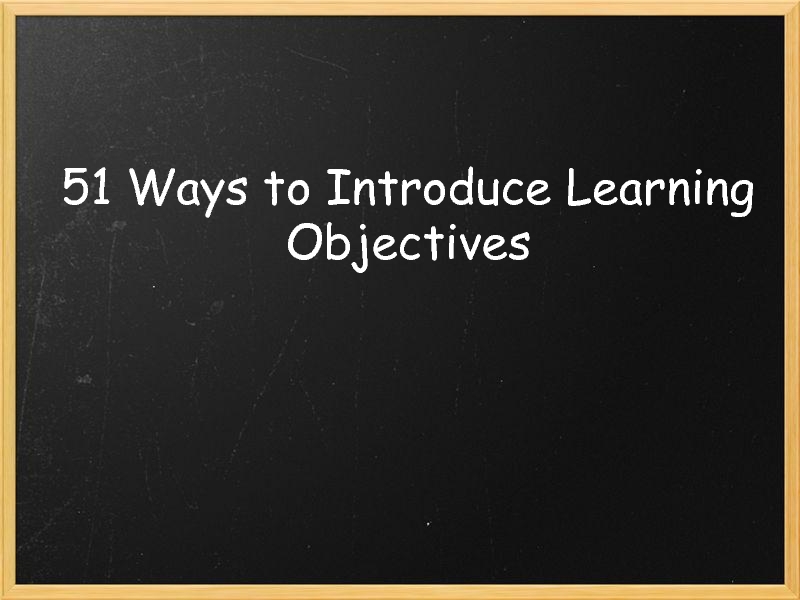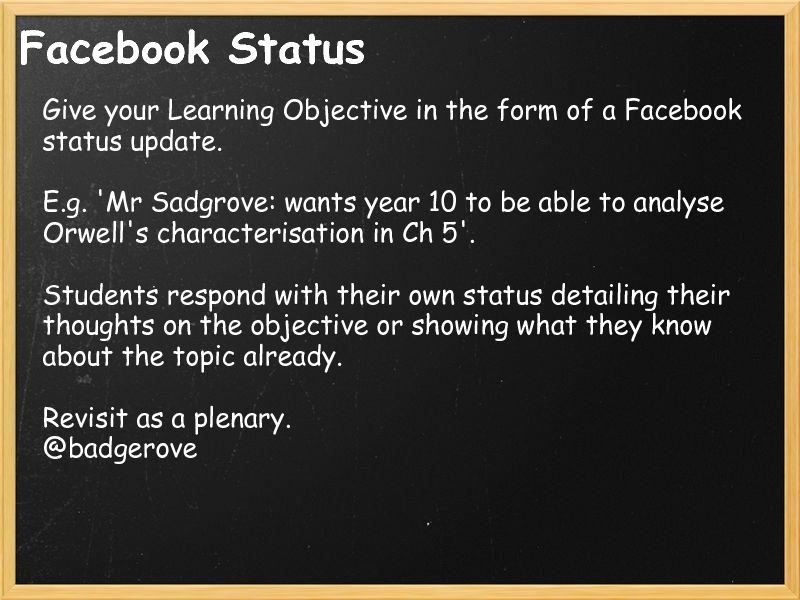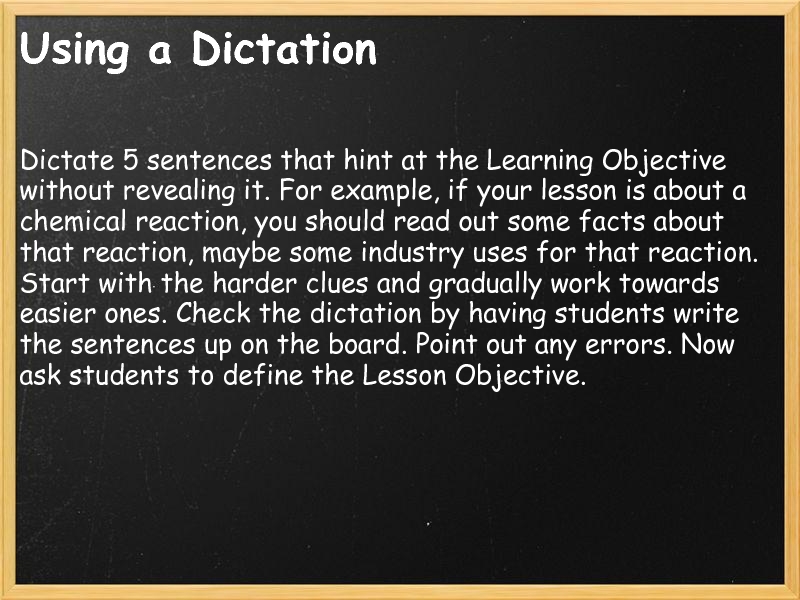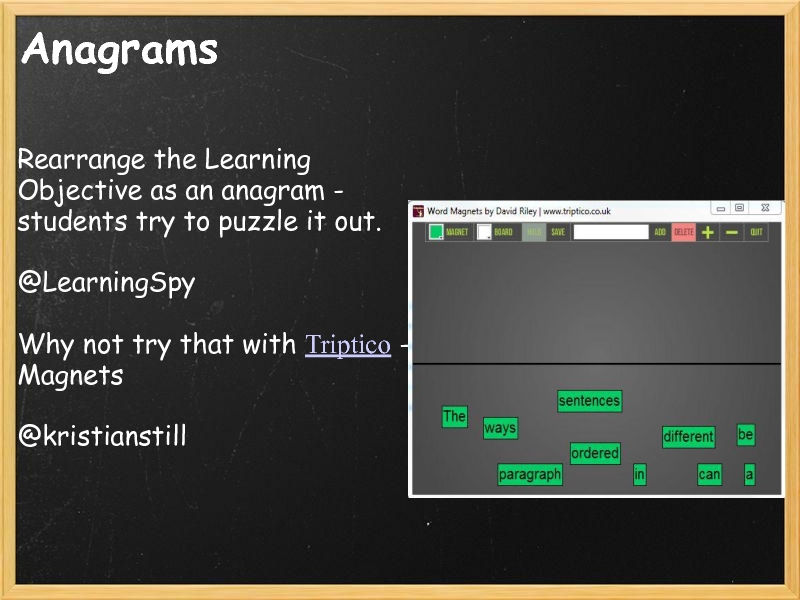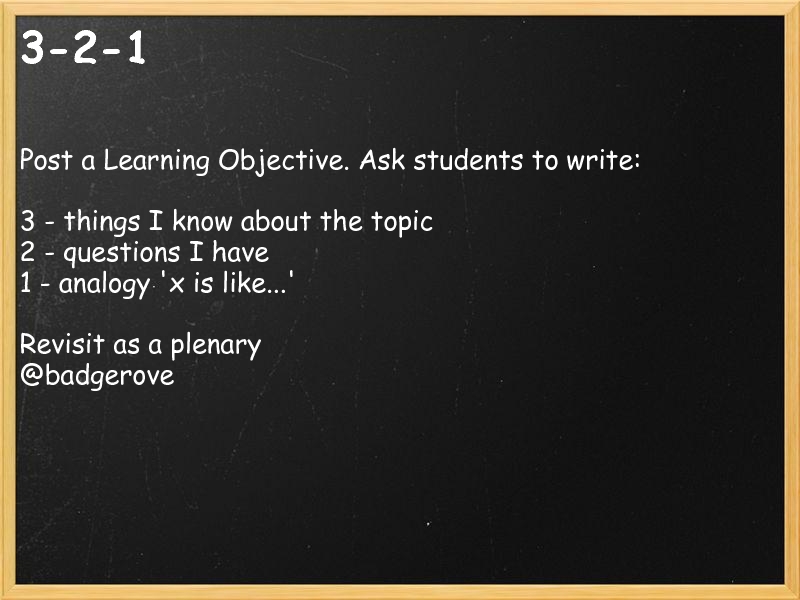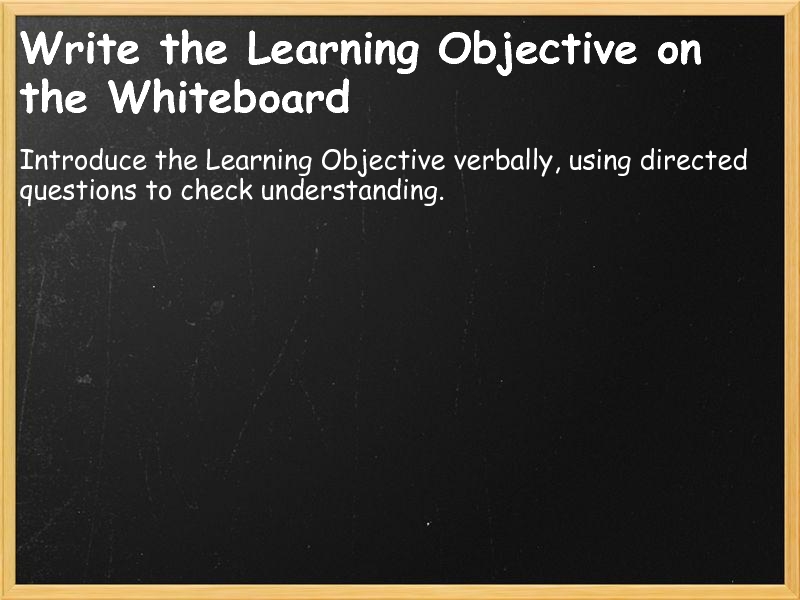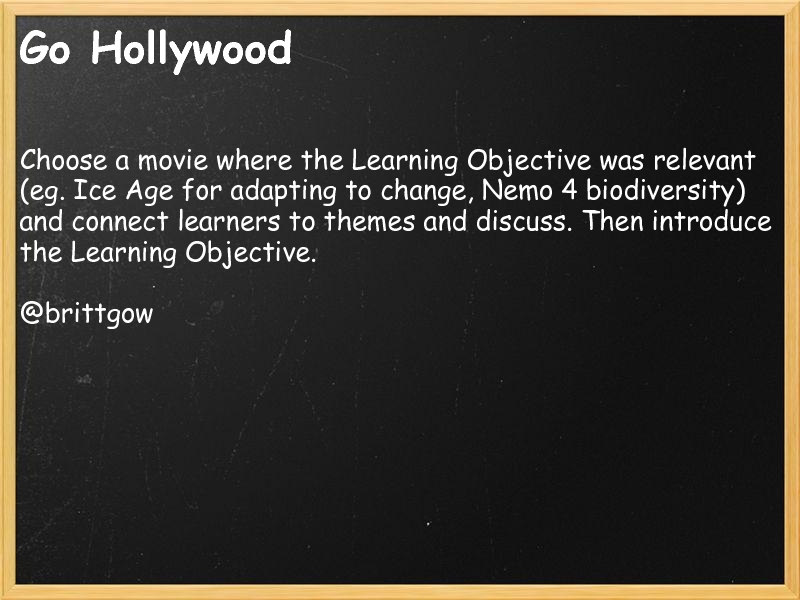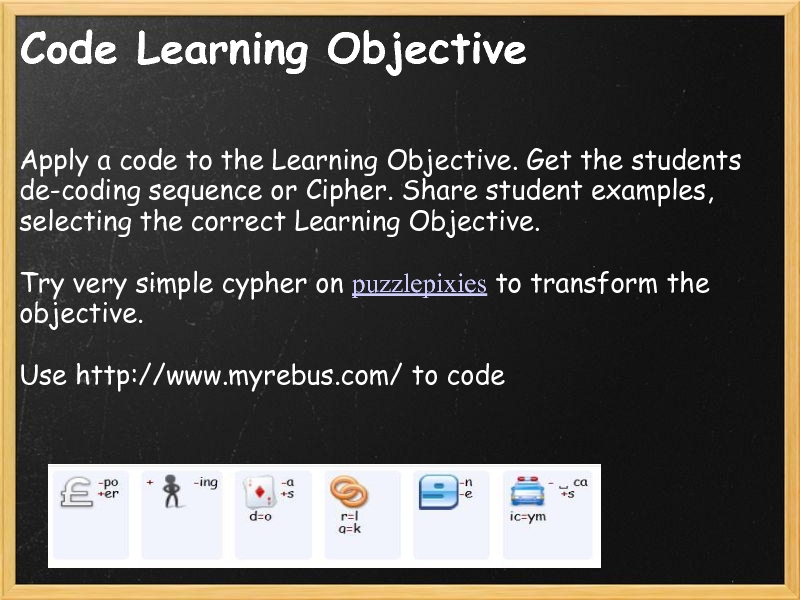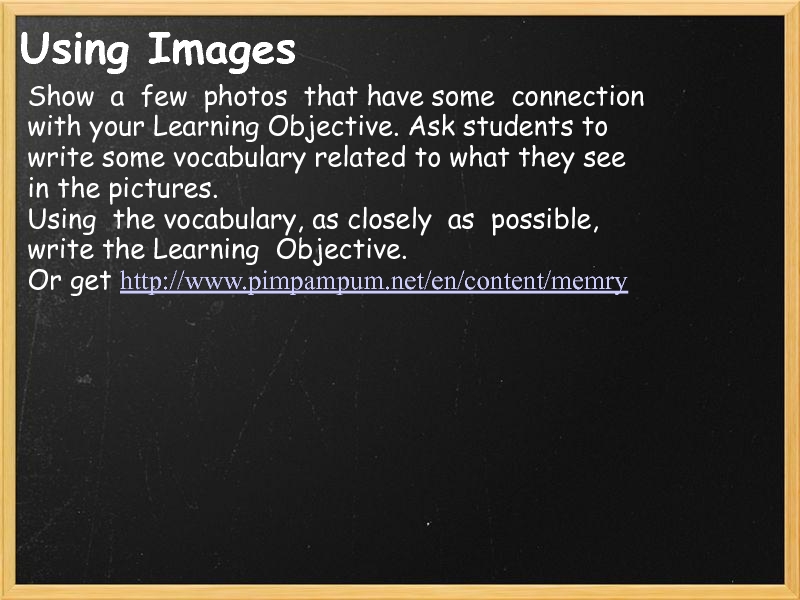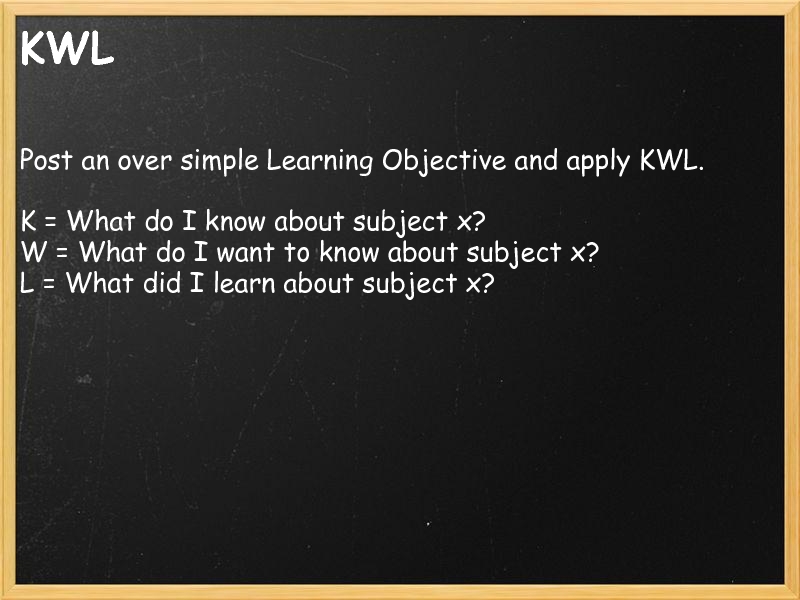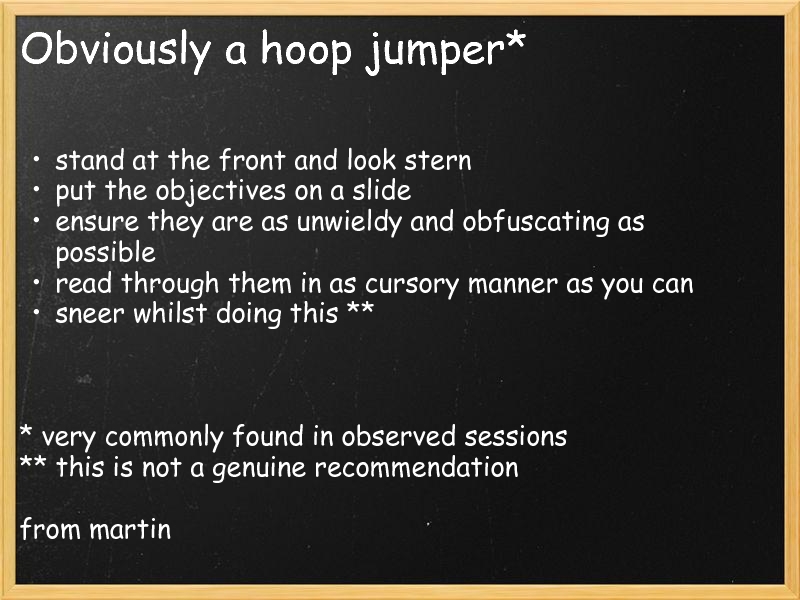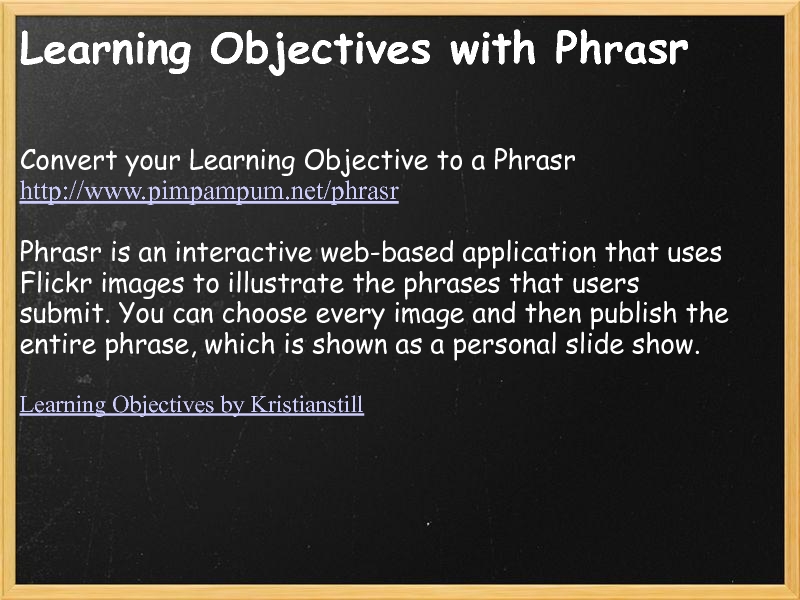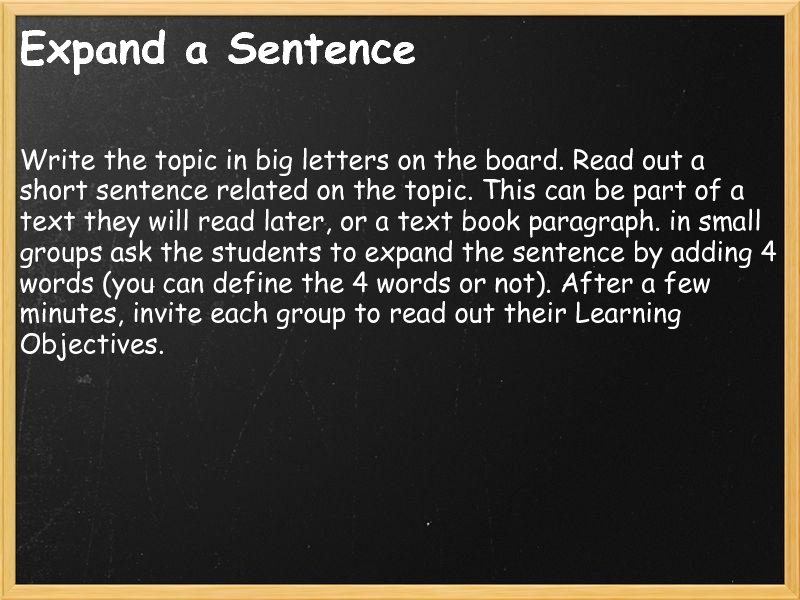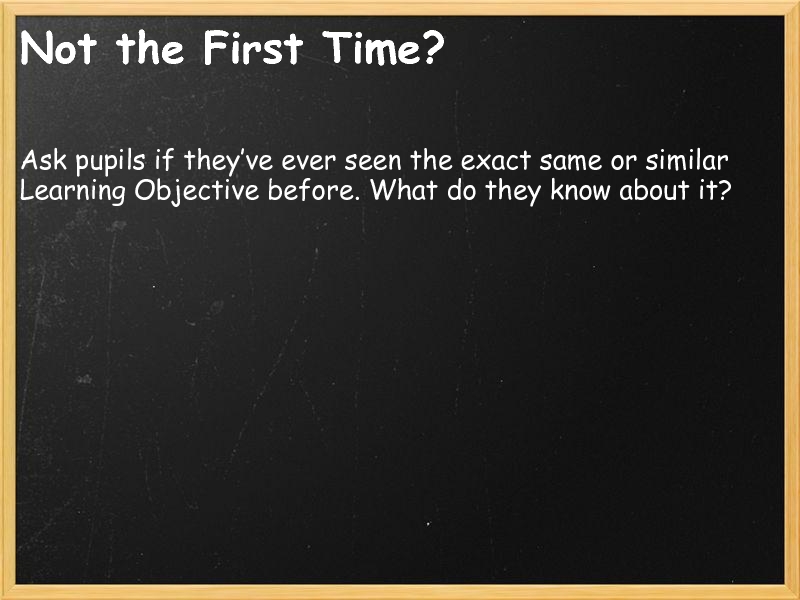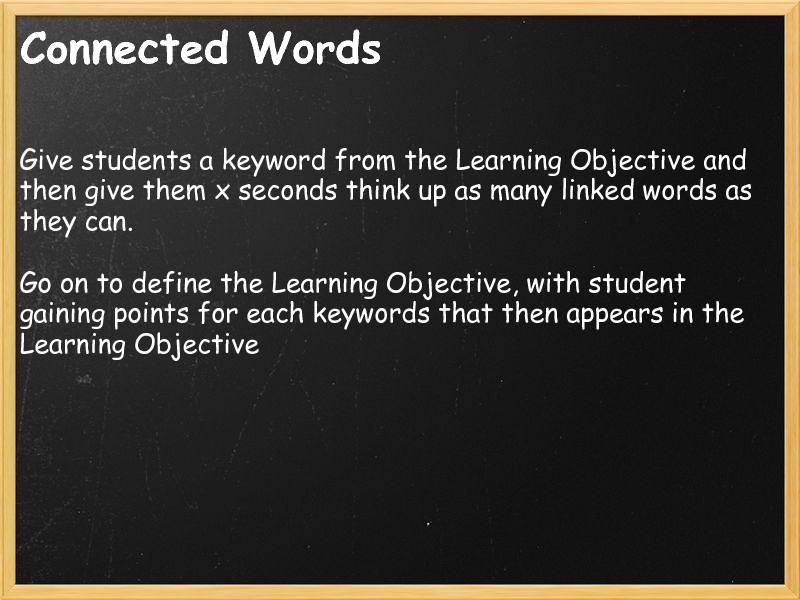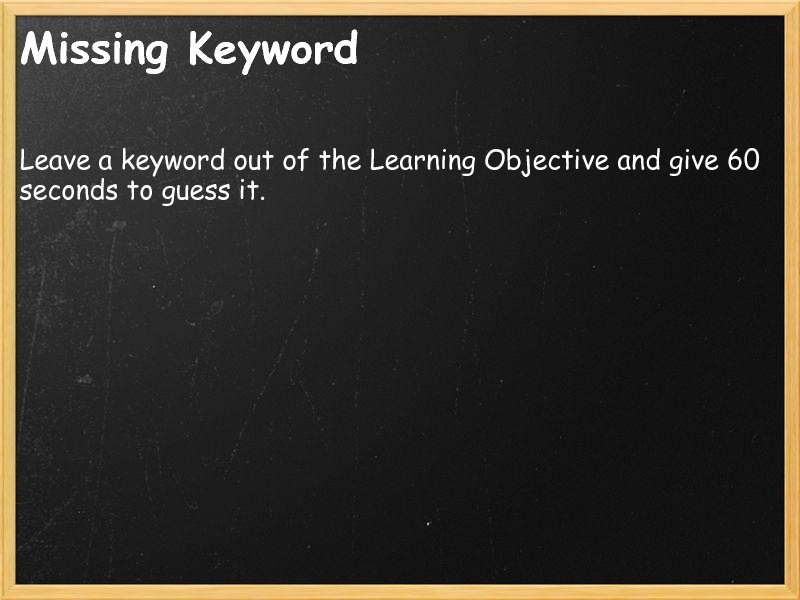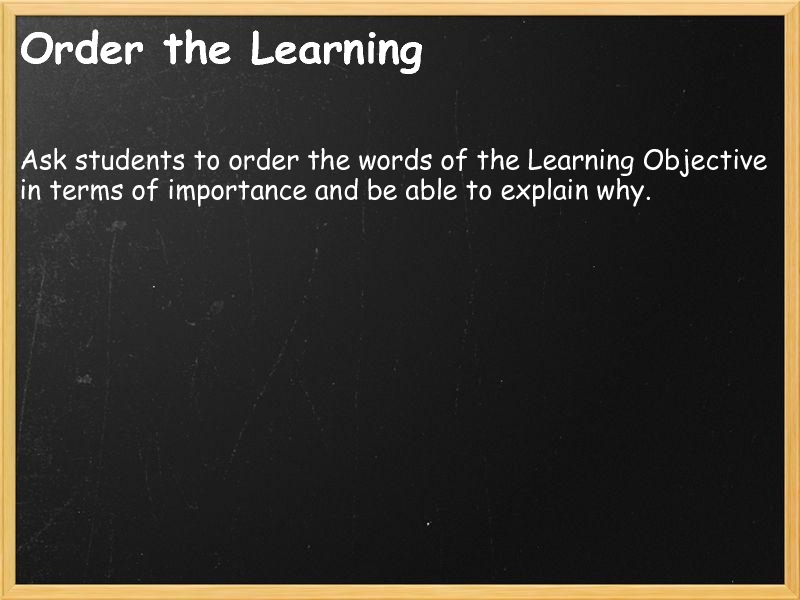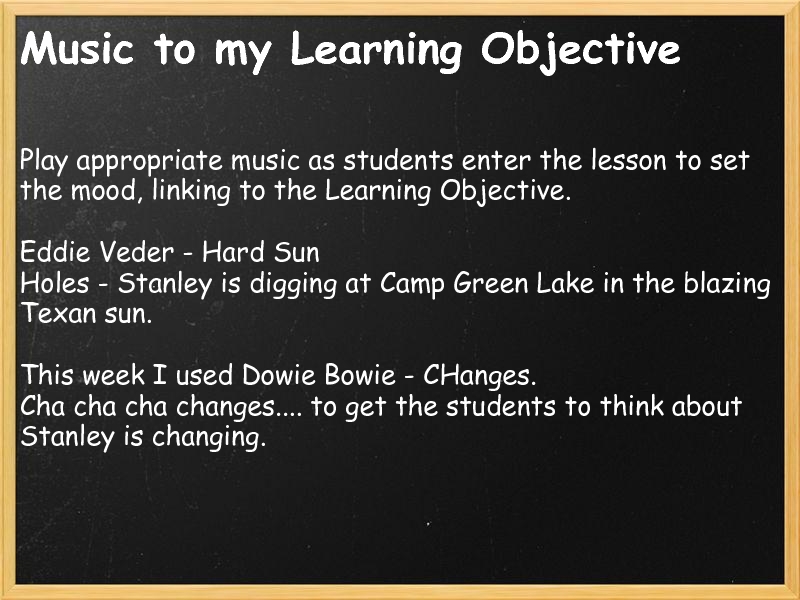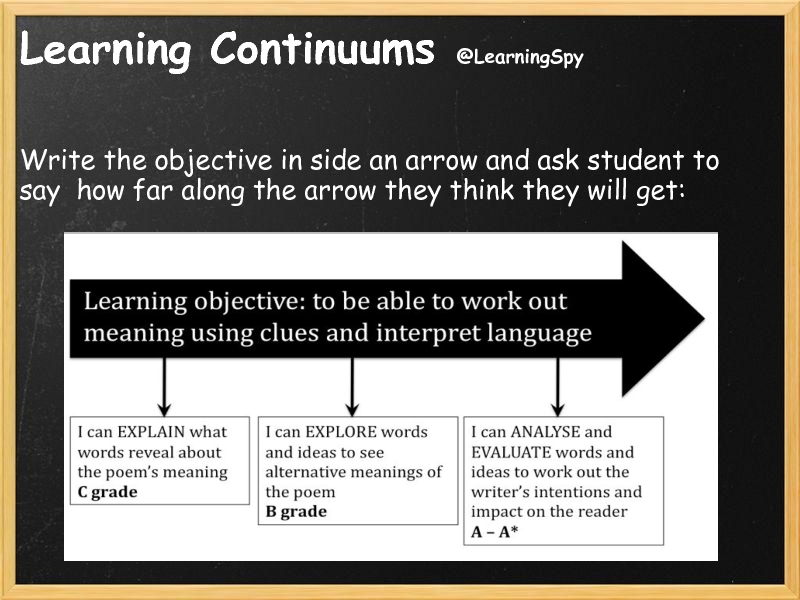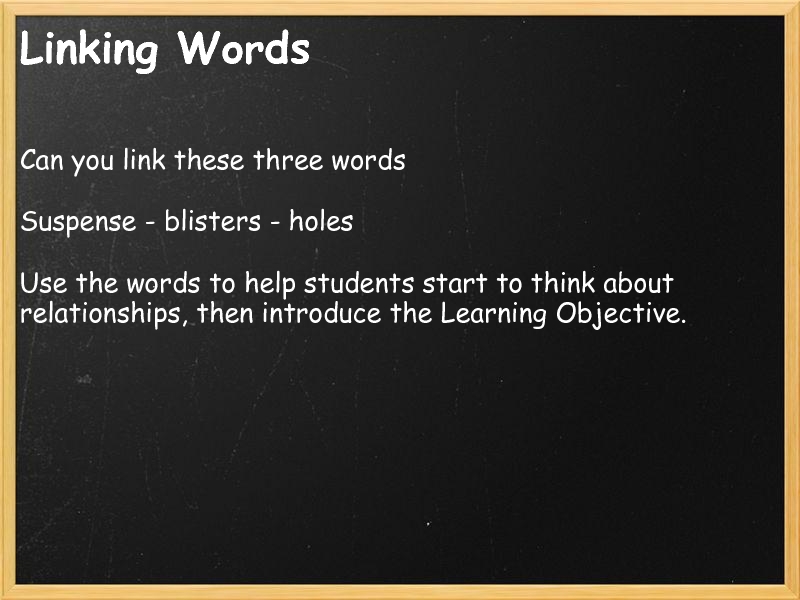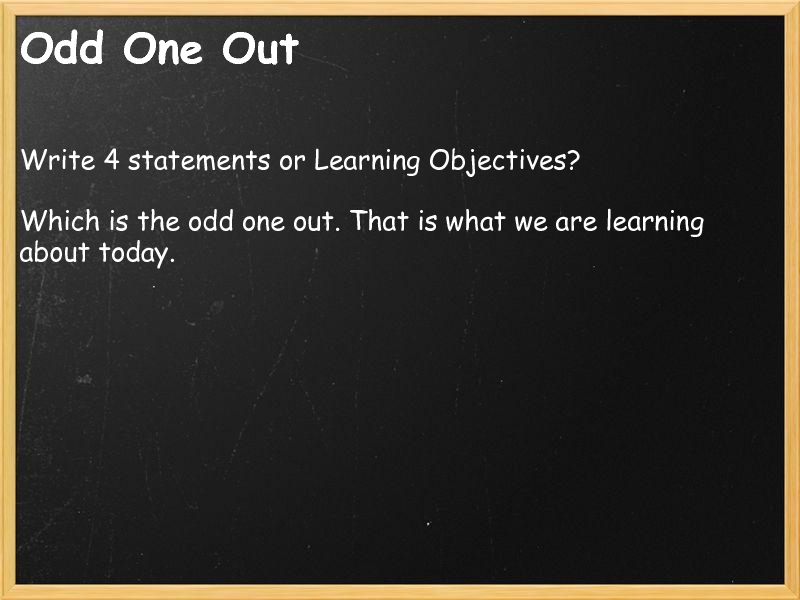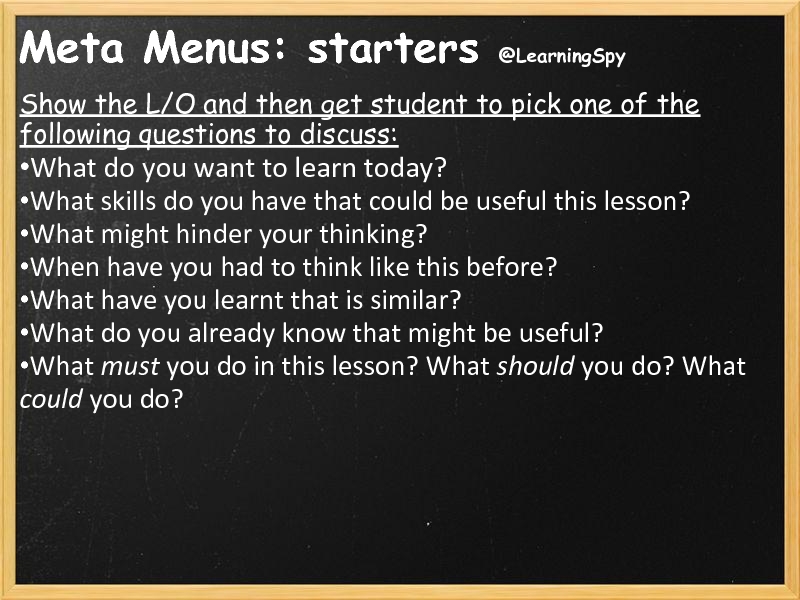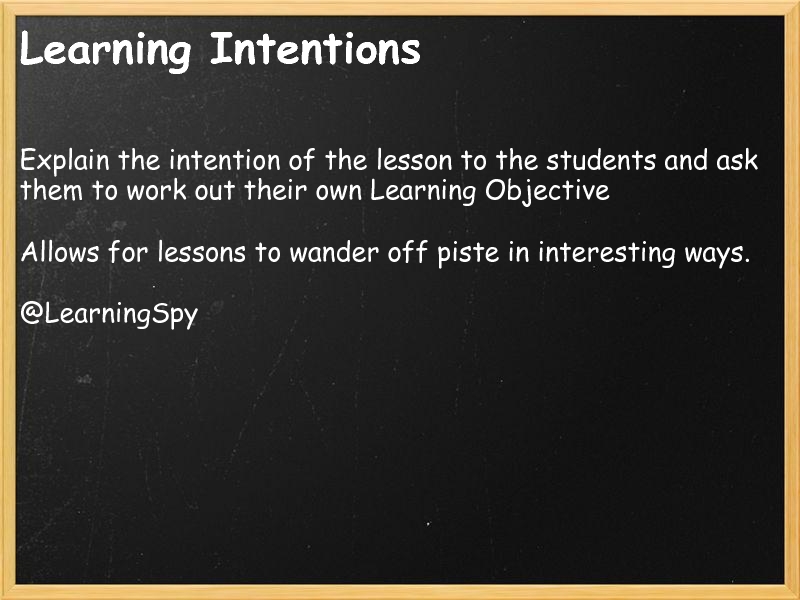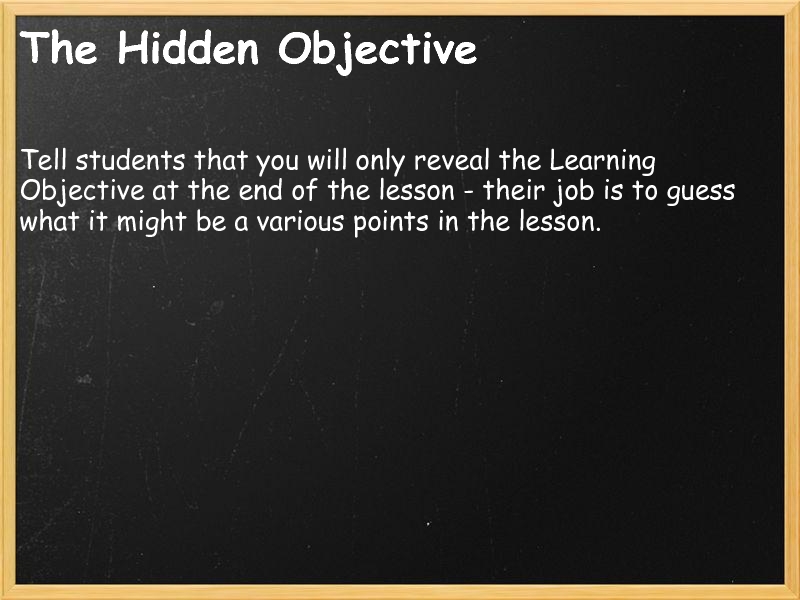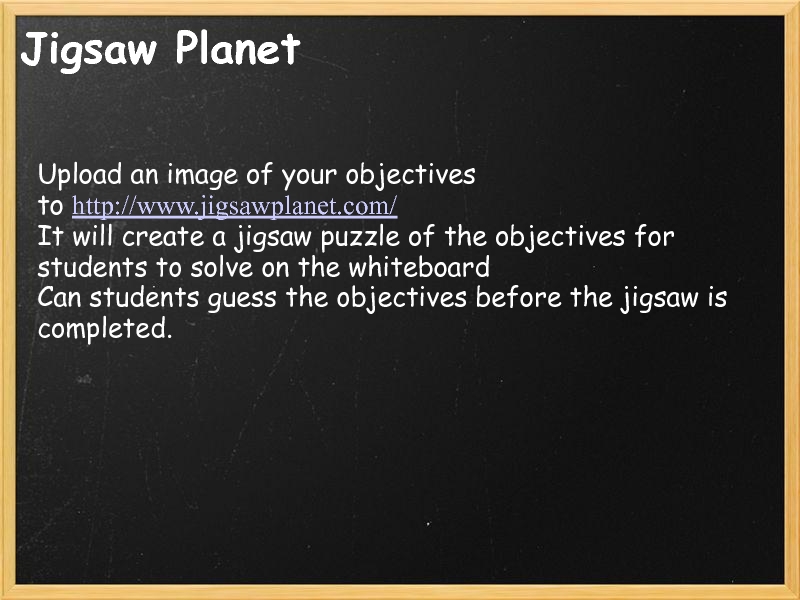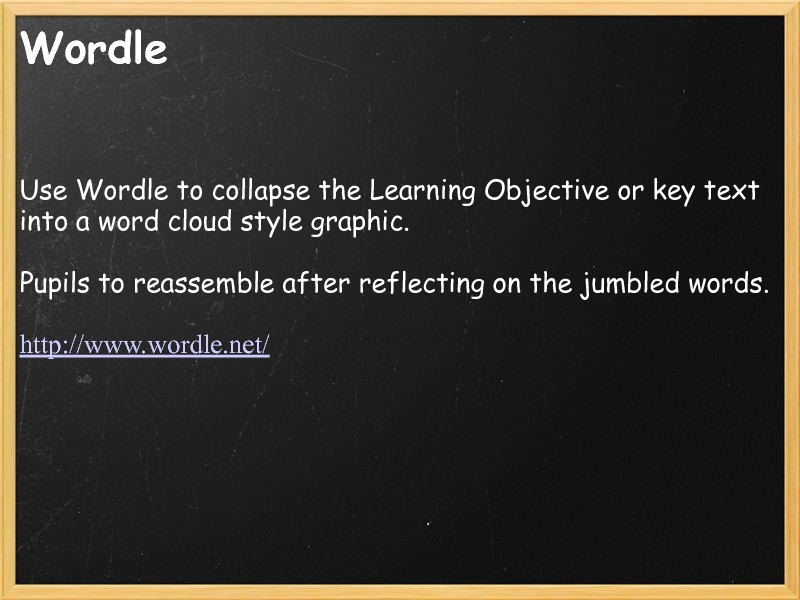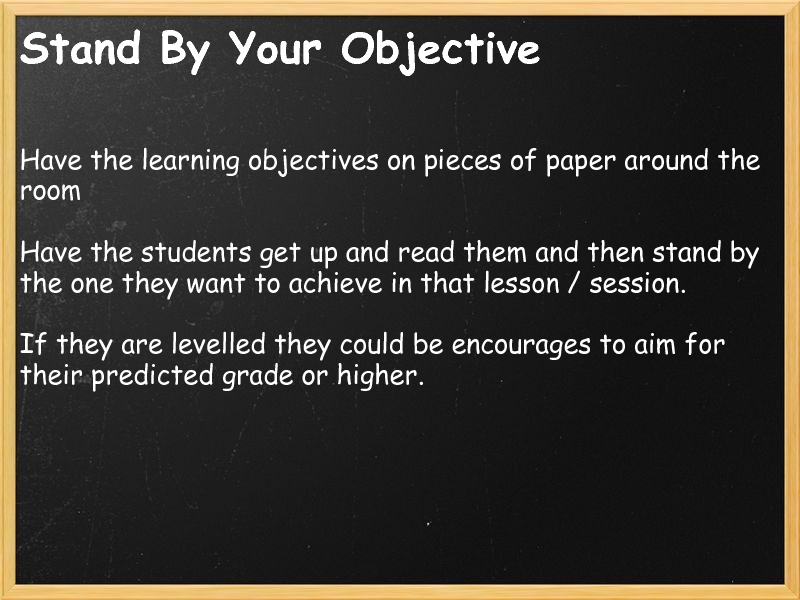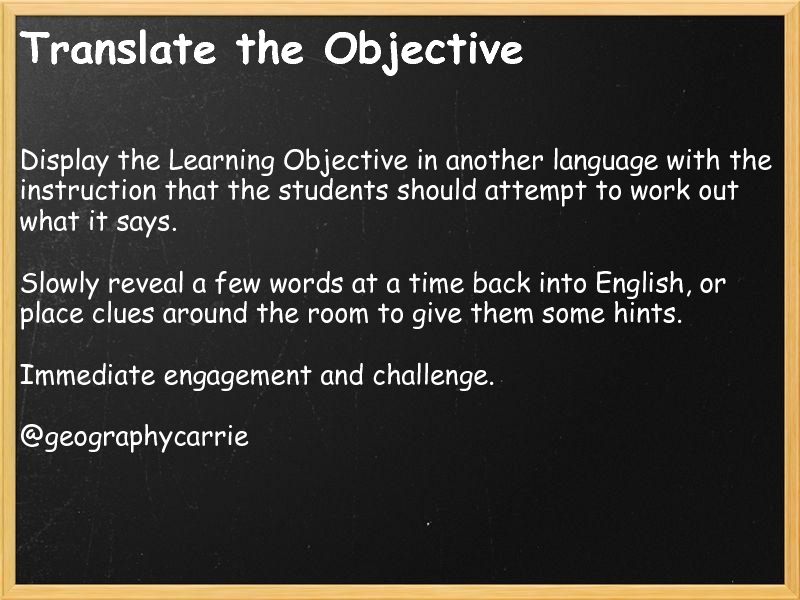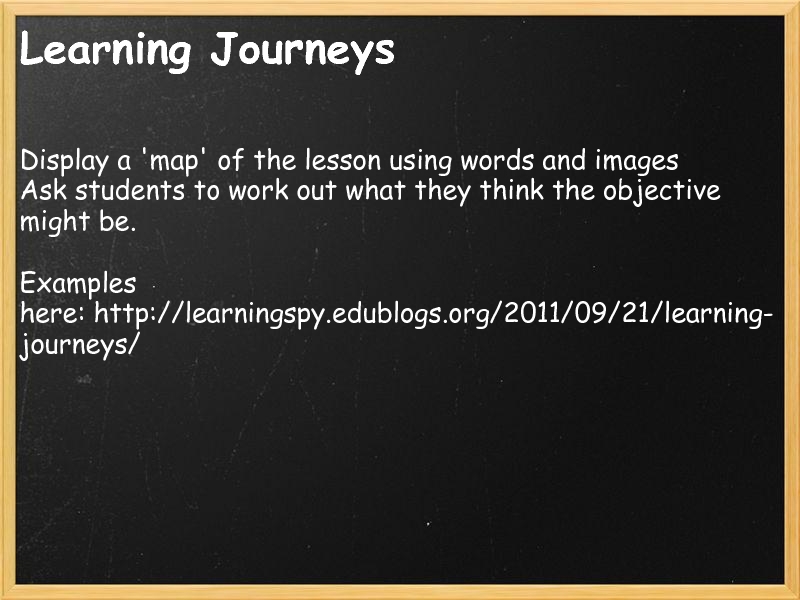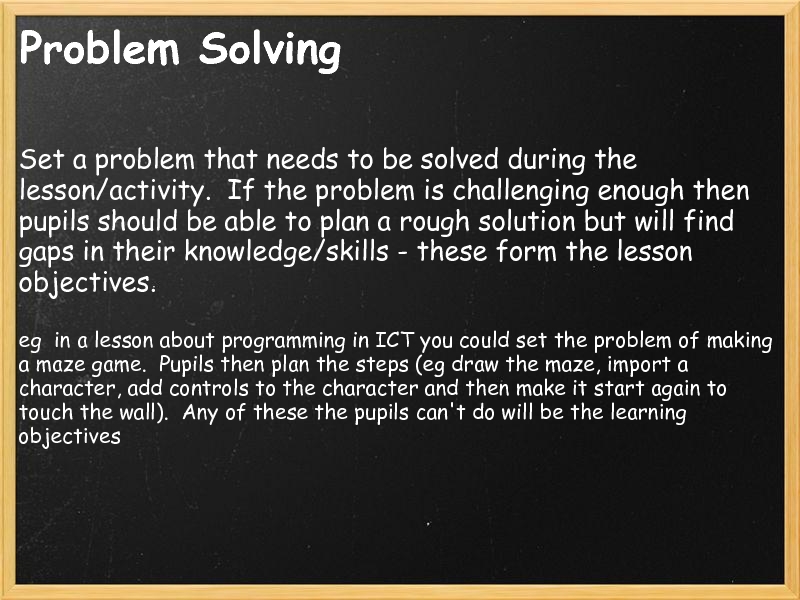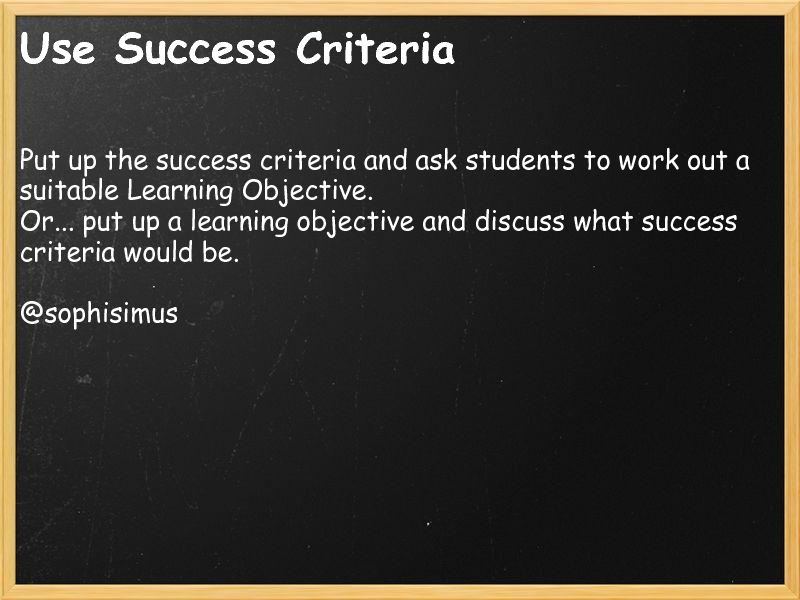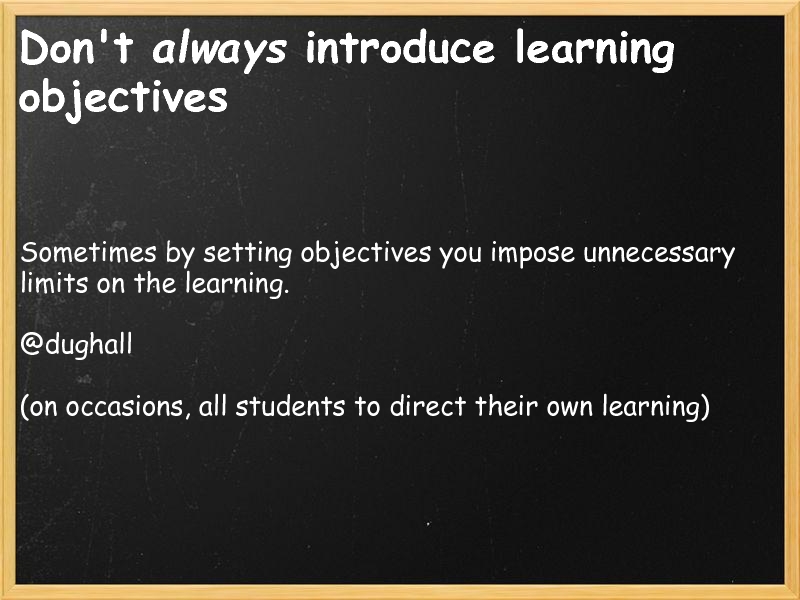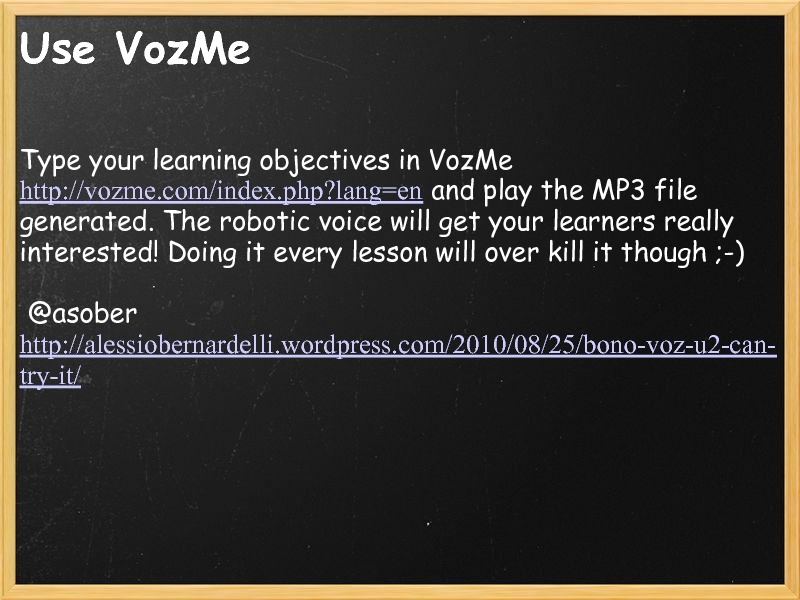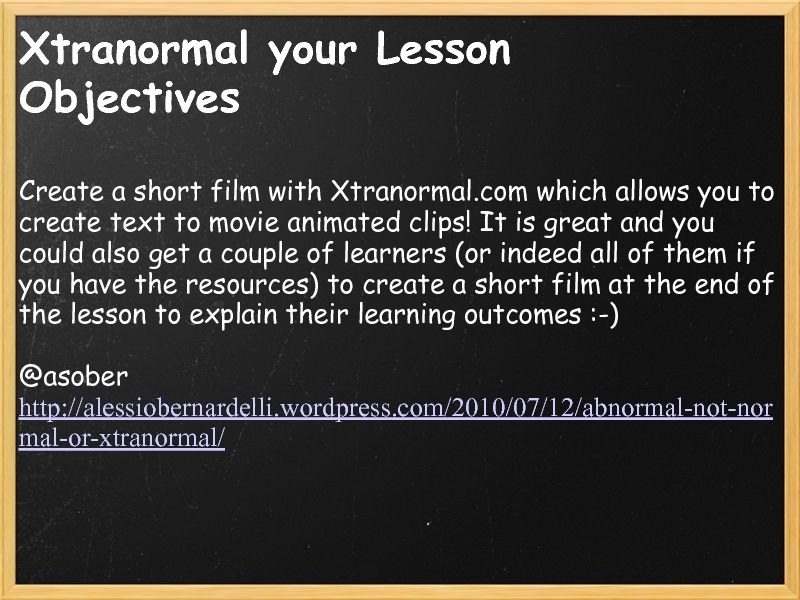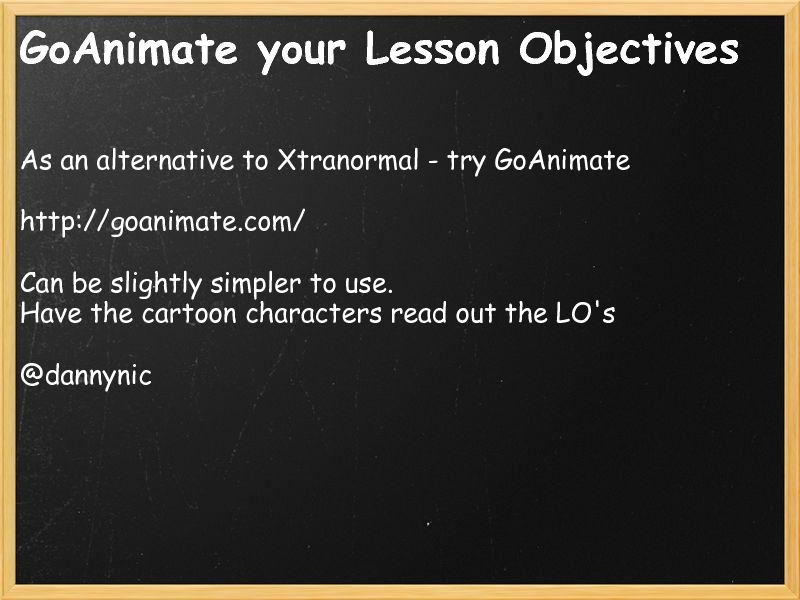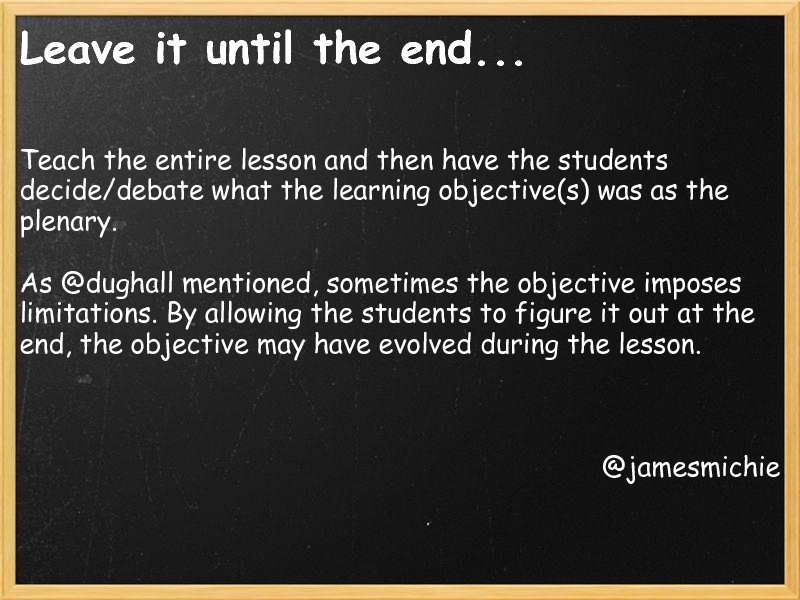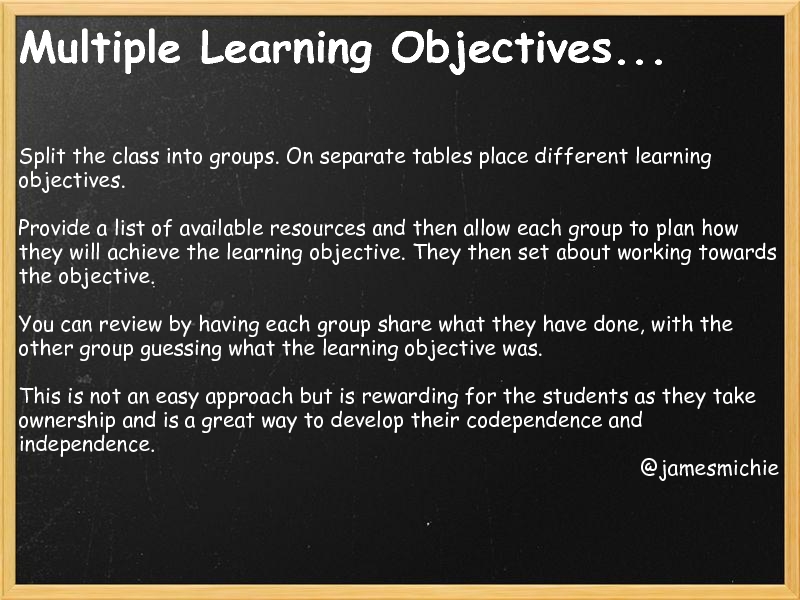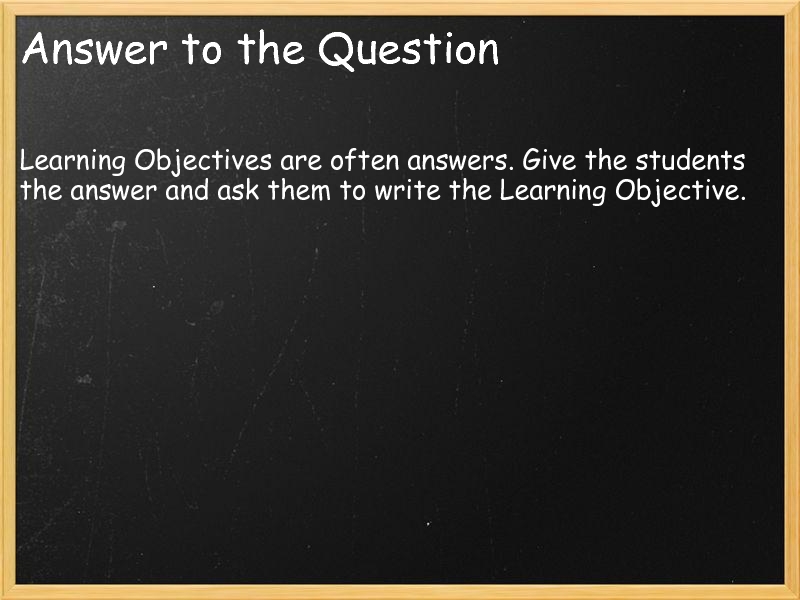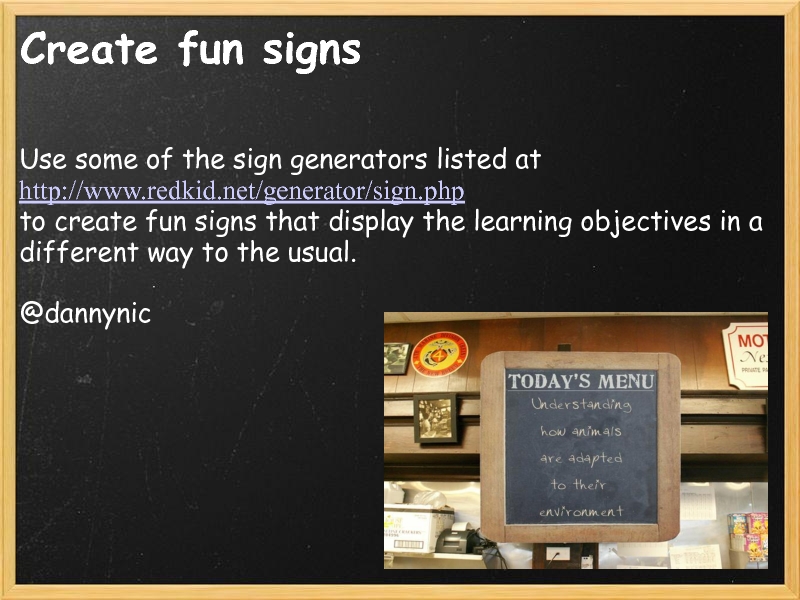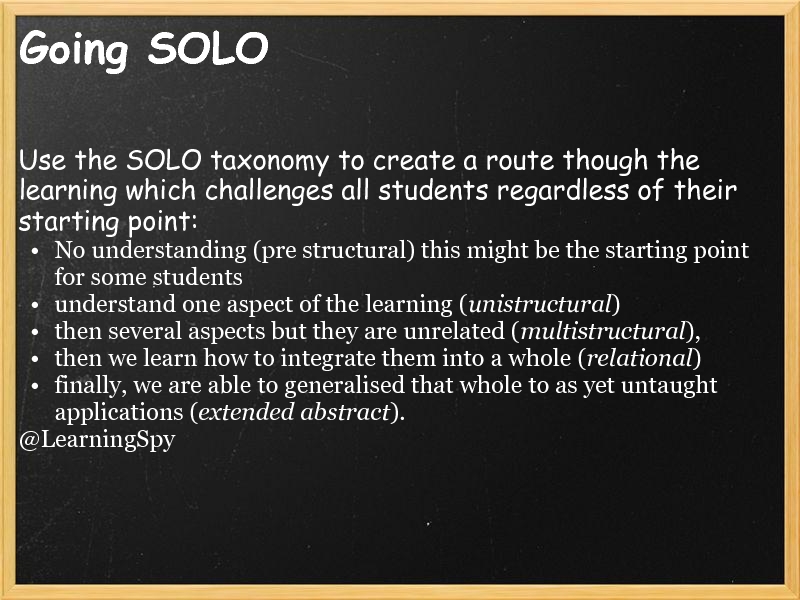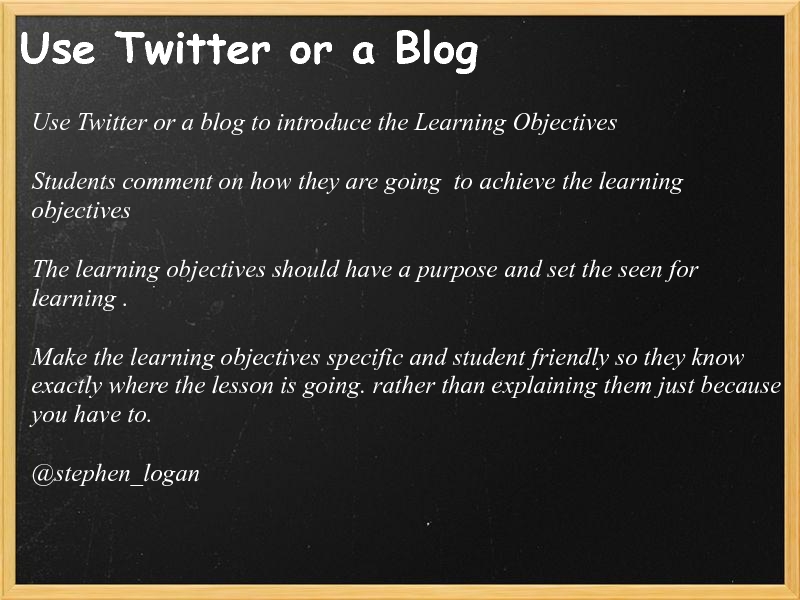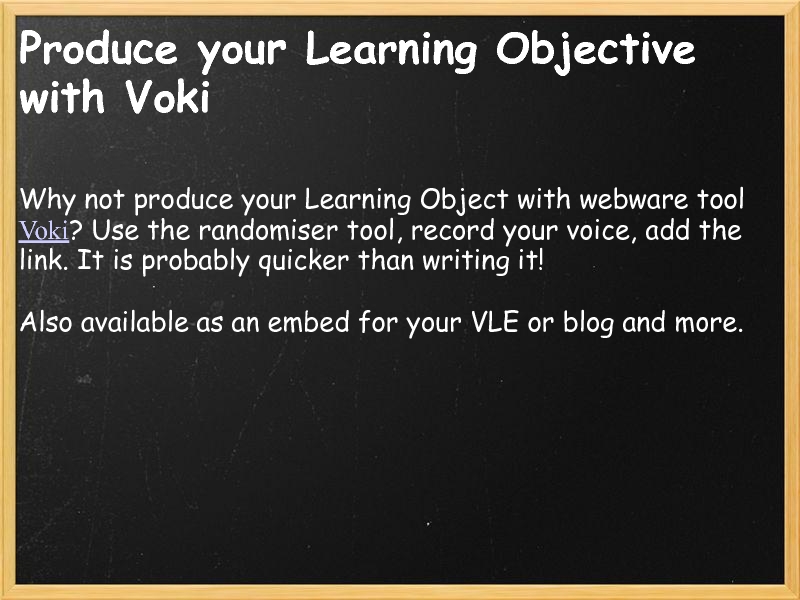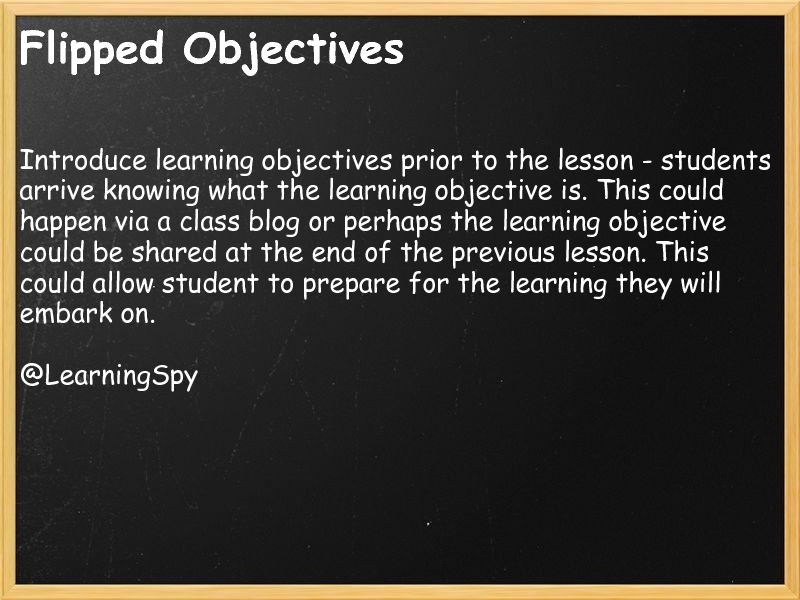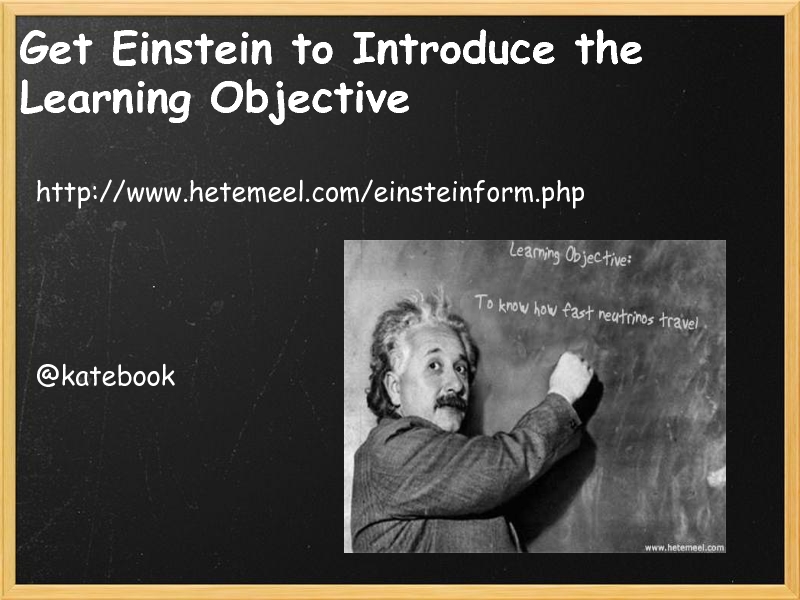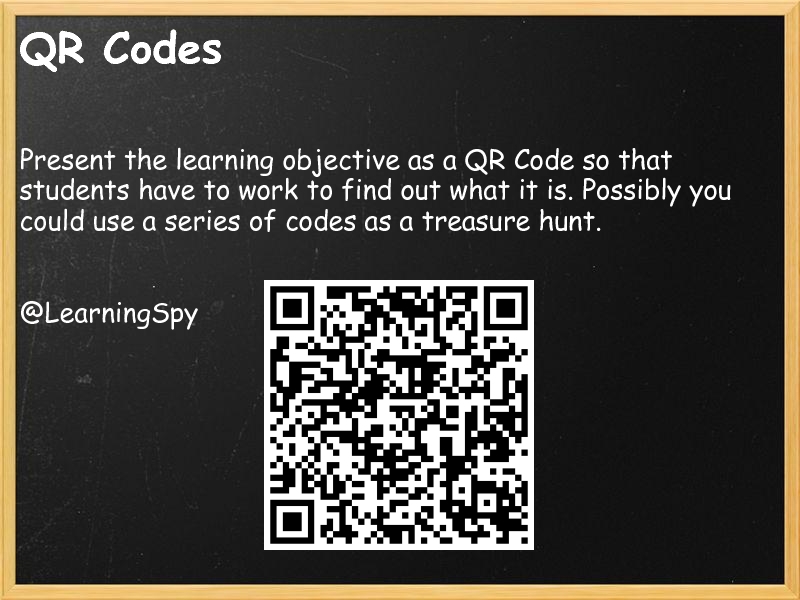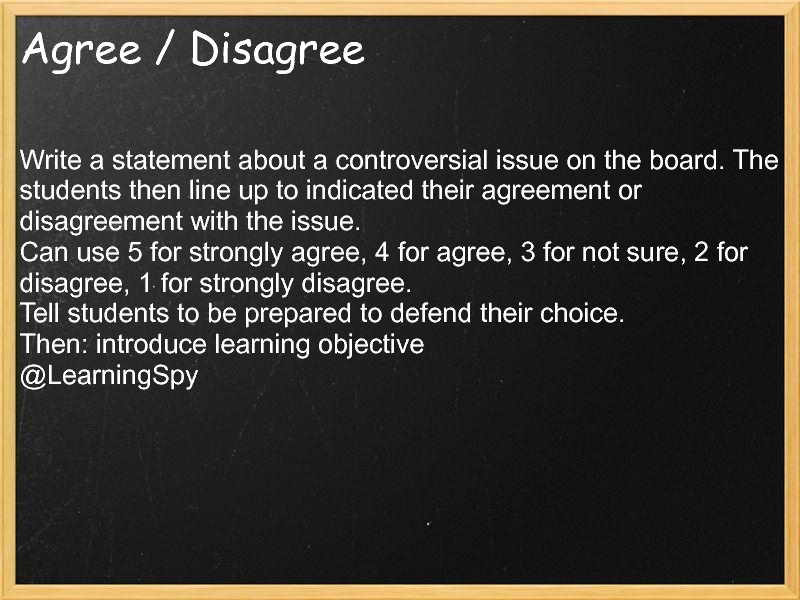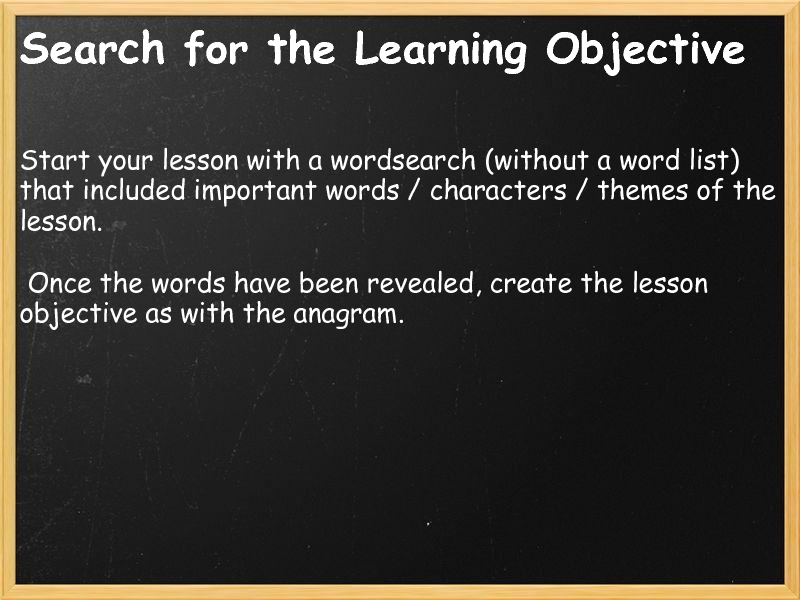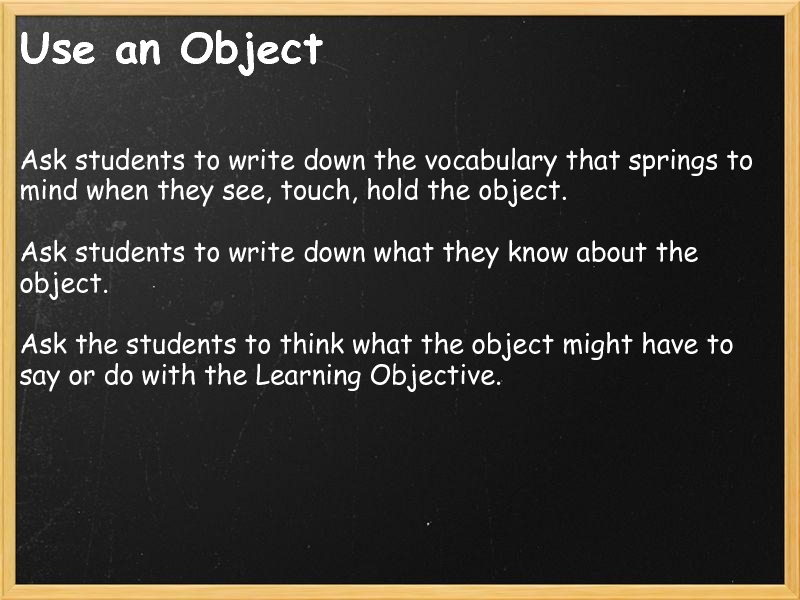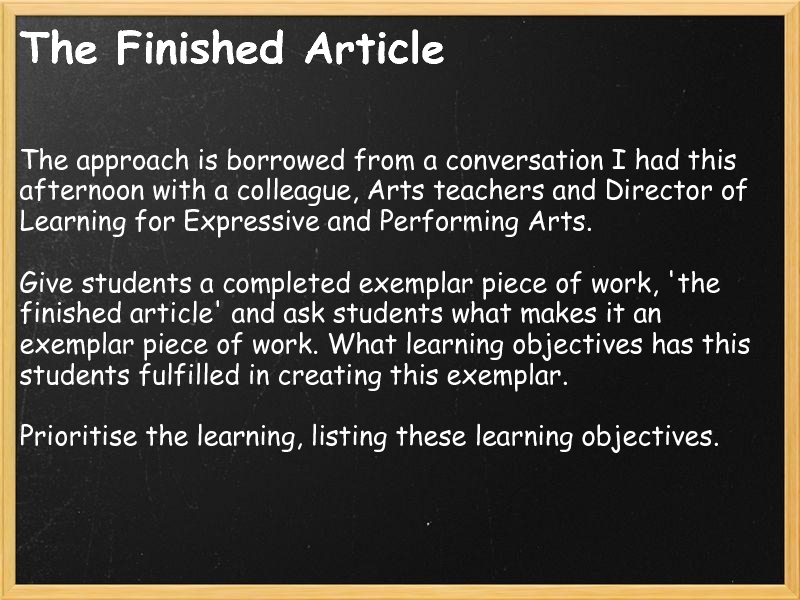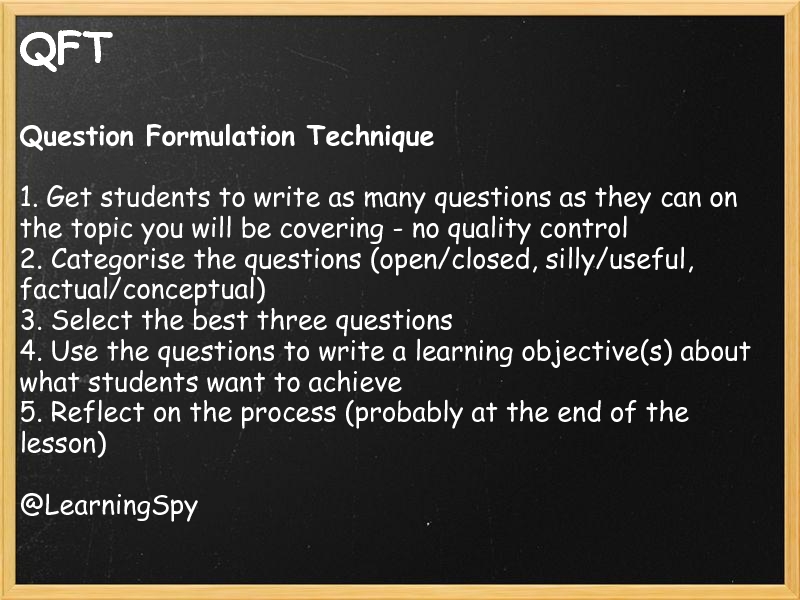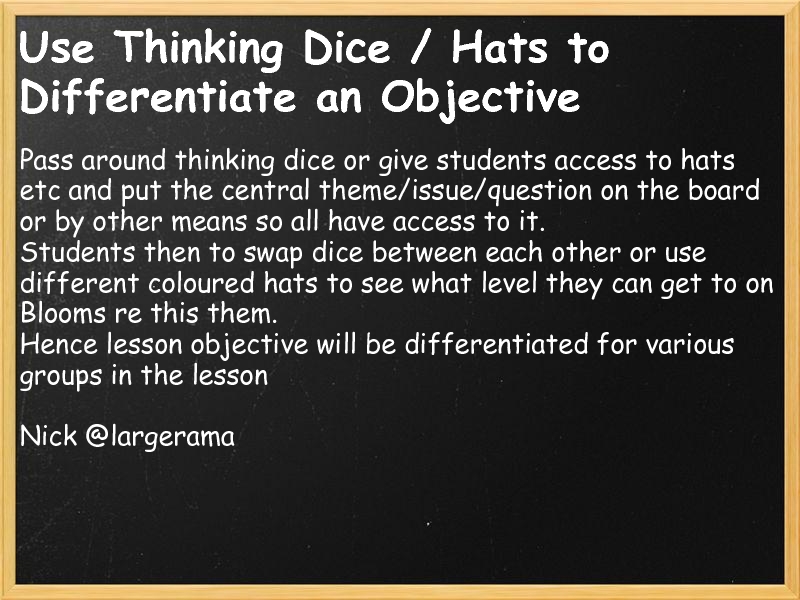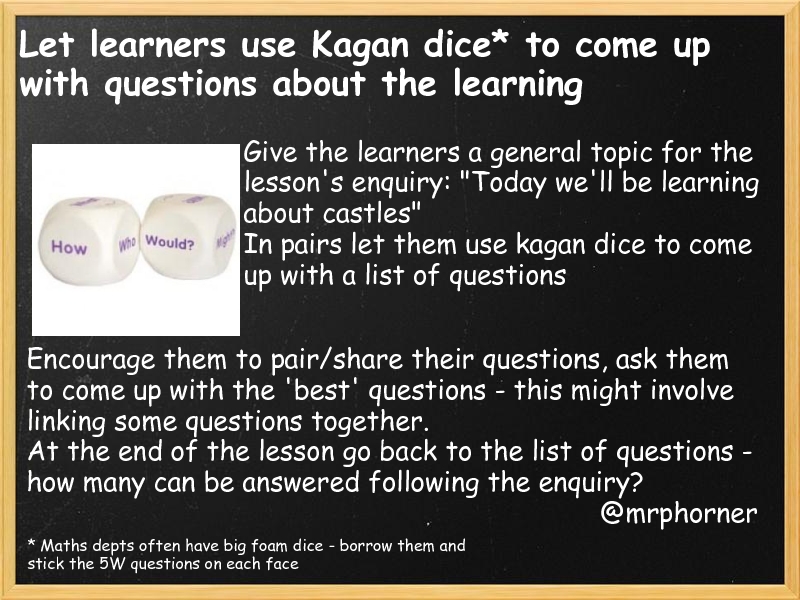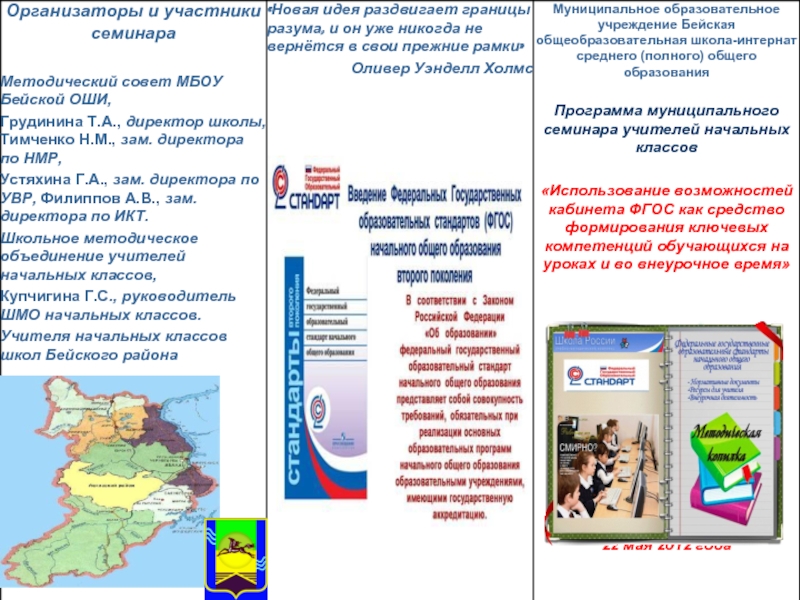- Главная
- Разное
- Дизайн
- Бизнес и предпринимательство
- Аналитика
- Образование
- Развлечения
- Красота и здоровье
- Финансы
- Государство
- Путешествия
- Спорт
- Недвижимость
- Армия
- Графика
- Культурология
- Еда и кулинария
- Лингвистика
- Английский язык
- Астрономия
- Алгебра
- Биология
- География
- Детские презентации
- Информатика
- История
- Литература
- Маркетинг
- Математика
- Медицина
- Менеджмент
- Музыка
- МХК
- Немецкий язык
- ОБЖ
- Обществознание
- Окружающий мир
- Педагогика
- Русский язык
- Технология
- Физика
- Философия
- Химия
- Шаблоны, картинки для презентаций
- Экология
- Экономика
- Юриспруденция
Ways to introduce learning objectives презентация
Содержание
- 1. Ways to introduce learning objectives
- 2. Facebook Status Give your Learning Objective in
- 3. Using a Dictation Dictate 5 sentences
- 4. Anagrams Rearrange the Learning Objective as an
- 5. 3-2-1 Post a Learning Objective. Ask students
- 6. Write the Learning Objective on the Whiteboard
- 7. Go Hollywood Choose a movie where the
- 8. Code Learning Objective Apply a code to
- 9. Using Images Show a few photos that have some connection with your Learning Objective. Ask students to write some vocabulary related to what they see in the pictures. Using the vocabulary, as closely as possible, write the Learning Objective. Or get http://www.pimpampum.net/en/content/memry
- 10. KWL Post an over simple Learning Objective
- 11. Obviously a hoop jumper* stand at the
- 12. Learning Objectives with Phrasr Convert your Learning
- 13. Expand a Sentence Write the topic in
- 14. Not the First Time? Ask pupils if
- 15. Connected Words Give students a keyword from
- 16. Missing Keyword Leave a keyword out of
- 17. Order the Learning Ask students to order
- 18. Music to my Learning Objective Play appropriate
- 19. Learning Continuums @LearningSpy Write the objective in side
- 20. Linking Words Can you link these three
- 21. Odd One Out Write 4 statements or
- 22. Meta Menus: starters @LearningSpy Show the L/O
- 23. Learning Intentions Explain the intention of the
- 24. The Hidden Objective Tell students that you
- 25. Jigsaw Planet Upload an image of
- 26. Wordle Use Wordle to collapse the
- 27. Stand By Your Objective Have the learning
- 28. Translate the Objective Display the Learning Objective
- 29. Learning Journeys Display a 'map' of the
- 30. Problem Solving Set a problem that needs
- 31. Use Success Criteria Put up the success
- 32. Don't always introduce learning objectives
- 33. Use VozMe Type your learning objectives in VozMe
- 34. Xtranormal your Lesson Objectives Create a short
- 35. GoAnimate your Lesson Objectives As an alternative
- 36. Leave it until the end... Teach the
- 37. Multiple Learning Objectives... Split the class into
- 38. Answer to the Question Learning Objectives are
- 39. Create fun signs Use some of the
- 40. Going SOLO Use the SOLO taxonomy to
- 41. Use Twitter or a Blog Use Twitter
- 42. Produce your Learning Objective with Voki Why
- 43. Flipped Objectives Introduce learning objectives prior to
- 44. Get Einstein to Introduce the Learning Objective http://www.hetemeel.com/einsteinform.php @katebook
- 45. QR Codes Present the learning objective as
- 46. Agree / Disagree Write a statement about
- 47. Search for the Learning Objective Start your
- 48. Use an Object Ask students to write
- 49. The Finished Article The approach is borrowed
- 50. QFT Question Formulation Technique 1.
- 51. Use Thinking Dice / Hats to Differentiate
- 52. Let learners use Kagan dice* to come
Слайд 2Facebook Status
Give your Learning Objective in the form of a Facebook
E.g. 'Mr Sadgrove: wants year 10 to be able to analyse Orwell's characterisation in Ch 5'.
Students respond with their own status detailing their thoughts on the objective or showing what they know about the topic already.
Revisit as a plenary.
@badgerove
Слайд 3Using a Dictation
Dictate 5 sentences that hint at the Learning
Слайд 4Anagrams
Rearrange the Learning Objective as an anagram - students try to
@LearningSpy
Why not try that with Triptico - Magnets
@kristianstill
Слайд 53-2-1
Post a Learning Objective. Ask students to write:
3 - things I
2 - questions I have
1 - analogy 'x is like...'
Revisit as a plenary
@badgerove
Слайд 6Write the Learning Objective on the Whiteboard
Introduce the Learning Objective verbally,
Слайд 7Go Hollywood
Choose a movie where the Learning Objective was relevant (eg.
@brittgow
Слайд 8Code Learning Objective
Apply a code to the Learning Objective. Get the
Try very simple cypher on puzzlepixies to transform the objective.
Use http://www.myrebus.com/ to code
Слайд 9Using Images
Show a few photos that have some connection with your Learning Objective. Ask students to write some vocabulary related to what they see in the pictures. Using the vocabulary, as closely as possible, write the Learning Objective.
Or get http://www.pimpampum.net/en/content/memry
Слайд 10KWL
Post an over simple Learning Objective and apply KWL.
K = What
W = What do I want to know about subject x?
L = What did I learn about subject x?
Слайд 11Obviously a hoop jumper*
stand at the front and look stern
put the
ensure they are as unwieldy and obfuscating as possible
read through them in as cursory manner as you can
sneer whilst doing this **
* very commonly found in observed sessions
** this is not a genuine recommendation
from martin
Слайд 12Learning Objectives with Phrasr
Convert your Learning Objective to a Phrasr
http://www.pimpampum.net/phrasr
Phrasr is
Learning Objectives by Kristianstill
Слайд 13Expand a Sentence
Write the topic in big letters on the board.
Слайд 14Not the First Time?
Ask pupils if they’ve ever seen the exact
Слайд 15Connected Words
Give students a keyword from the Learning Objective and then
Go on to define the Learning Objective, with student gaining points for each keywords that then appears in the Learning Objective
Слайд 16Missing Keyword
Leave a keyword out of the Learning Objective and give
Слайд 17Order the Learning
Ask students to order the words of the Learning
Слайд 18Music to my Learning Objective
Play appropriate music as students enter the
Eddie Veder - Hard Sun
Holes - Stanley is digging at Camp Green Lake in the blazing Texan sun.
This week I used Dowie Bowie - CHanges.
Cha cha cha changes.... to get the students to think about Stanley is changing.
Слайд 19Learning Continuums @LearningSpy
Write the objective in side an arrow and ask student
Слайд 20Linking Words
Can you link these three words
Suspense - blisters - holes
Use
Слайд 21Odd One Out
Write 4 statements or Learning Objectives?
Which is the odd
Слайд 22Meta Menus: starters @LearningSpy
Show the L/O and then get student to
•What do you want to learn today?
•What skills do you have that could be useful this lesson?
•What might hinder your thinking?
•When have you had to think like this before?
•What have you learnt that is similar?
•What do you already know that might be useful?
•What must you do in this lesson? What should you do? What could you do?
Слайд 23Learning Intentions
Explain the intention of the lesson to the students and
Allows for lessons to wander off piste in interesting ways.
@LearningSpy
Слайд 24The Hidden Objective
Tell students that you will only reveal the Learning
Слайд 25Jigsaw Planet
Upload an image of your objectives to http://www.jigsawplanet.com/
It will create a
Can students guess the objectives before the jigsaw is completed.
Слайд 26Wordle
Use Wordle to collapse the Learning Objective or key text into
Pupils to reassemble after reflecting on the jumbled words.
http://www.wordle.net/
Слайд 27Stand By Your Objective
Have the learning objectives on pieces of paper
Have the students get up and read them and then stand by the one they want to achieve in that lesson / session.
If they are levelled they could be encourages to aim for their predicted grade or higher.
Слайд 28Translate the Objective
Display the Learning Objective in another language with the
Slowly reveal a few words at a time back into English, or place clues around the room to give them some hints.
Immediate engagement and challenge.
@geographycarrie
Слайд 29Learning Journeys
Display a 'map' of the lesson using words and images
Ask
Examples here: http://learningspy.edublogs.org/2011/09/21/learning-journeys/
Слайд 30Problem Solving
Set a problem that needs to be solved during the
eg in a lesson about programming in ICT you could set the problem of making a maze game. Pupils then plan the steps (eg draw the maze, import a character, add controls to the character and then make it start again to touch the wall). Any of these the pupils can't do will be the learning objectives
Слайд 31Use Success Criteria
Put up the success criteria and ask students to
Or... put up a learning objective and discuss what success criteria would be.
@sophisimus
Слайд 32Don't always introduce learning objectives
Sometimes by setting objectives you impose unnecessary
@dughall
(on occasions, all students to direct their own learning)
Слайд 33Use VozMe
Type your learning objectives in VozMe http://vozme.com/index.php?lang=en and play the MP3 file generated.
@asober
http://alessiobernardelli.wordpress.com/2010/08/25/bono-voz-u2-can-try-it/
Слайд 34Xtranormal your Lesson Objectives
Create a short film with Xtranormal.com which allows
@asober
http://alessiobernardelli.wordpress.com/2010/07/12/abnormal-not-normal-or-xtranormal/
Слайд 35GoAnimate your Lesson Objectives
As an alternative to Xtranormal - try GoAnimate
http://goanimate.com/
Can
Have the cartoon characters read out the LO's
@dannynic
Слайд 36Leave it until the end...
Teach the entire lesson and then have
As @dughall mentioned, sometimes the objective imposes limitations. By allowing the students to figure it out at the end, the objective may have evolved during the lesson.
@jamesmichie
Слайд 37Multiple Learning Objectives...
Split the class into groups. On separate tables place
Provide a list of available resources and then allow each group to plan how they will achieve the learning objective. They then set about working towards the objective.
You can review by having each group share what they have done, with the other group guessing what the learning objective was.
This is not an easy approach but is rewarding for the students as they take ownership and is a great way to develop their codependence and independence.
@jamesmichie
Слайд 38Answer to the Question
Learning Objectives are often answers. Give the students
Слайд 39Create fun signs
Use some of the sign generators listed at
http://www.redkid.net/generator/sign.php
to create
@dannynic
Слайд 40Going SOLO
Use the SOLO taxonomy to create a route though the
No understanding (pre structural) this might be the starting point for some students
understand one aspect of the learning (unistructural)
then several aspects but they are unrelated (multistructural),
then we learn how to integrate them into a whole (relational)
finally, we are able to generalised that whole to as yet untaught applications (extended abstract).
@LearningSpy
Слайд 41Use Twitter or a Blog
Use Twitter or a blog to introduce
Students comment on how they are going to achieve the learning objectives
The learning objectives should have a purpose and set the seen for learning .
Make the learning objectives specific and student friendly so they know exactly where the lesson is going. rather than explaining them just because you have to.
@stephen_logan
Слайд 42Produce your Learning Objective with Voki
Why not produce your Learning Object
Also available as an embed for your VLE or blog and more.
Слайд 43Flipped Objectives
Introduce learning objectives prior to the lesson - students arrive
@LearningSpy
Слайд 44Get Einstein to Introduce the Learning Objective
http://www.hetemeel.com/einsteinform.php
@katebook
Слайд 45QR Codes
Present the learning objective as a QR Code so that
@LearningSpy
Слайд 46Agree / Disagree
Write a statement about a controversial issue on the
Can use 5 for strongly agree, 4 for agree, 3 for not sure, 2 for disagree, 1 for strongly disagree.
Tell students to be prepared to defend their choice.
Then: introduce learning objective
@LearningSpy
Слайд 47Search for the Learning Objective
Start your lesson with a wordsearch (without
Once the words have been revealed, create the lesson objective as with the anagram.
Слайд 48Use an Object
Ask students to write down the vocabulary that springs
Ask students to write down what they know about the object.
Ask the students to think what the object might have to say or do with the Learning Objective.
Слайд 49The Finished Article
The approach is borrowed from a conversation I had
Give students a completed exemplar piece of work, 'the finished article' and ask students what makes it an exemplar piece of work. What learning objectives has this students fulfilled in creating this exemplar.
Prioritise the learning, listing these learning objectives.
Слайд 50QFT
Question Formulation Technique
1. Get students to write as many questions
2. Categorise the questions (open/closed, silly/useful, factual/conceptual)
3. Select the best three questions
4. Use the questions to write a learning objective(s) about what students want to achieve
5. Reflect on the process (probably at the end of the lesson)
@LearningSpy
Слайд 51Use Thinking Dice / Hats to Differentiate an Objective
Pass around thinking
Students then to swap dice between each other or use different coloured hats to see what level they can get to on Blooms re this them.
Hence lesson objective will be differentiated for various groups in the lesson
Nick @largerama
Слайд 52Let learners use Kagan dice* to come up with questions about
Give the learners a general topic for the lesson's enquiry: "Today we'll be learning about castles"
In pairs let them use kagan dice to come up with a list of questions
Encourage them to pair/share their questions, ask them to come up with the 'best' questions - this might involve linking some questions together.
At the end of the lesson go back to the list of questions - how many can be answered following the enquiry?
@mrphorner
* Maths depts often have big foam dice - borrow them and stick the 5W questions on each face
